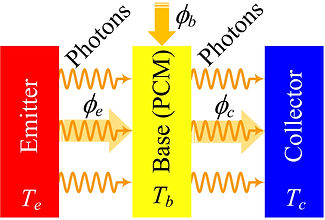
1. Thermal Transistor
Guiding, amplification, and control of electrical and thermal currents are of critical importance to efficiently manage the energy resources of nature. In electricity, this has been done with diodes and transistors, which have revolutionized our daily life. Thermal analogues of these fundamental electronic components making possible the heat current control do not exist yet, despite the fact that around 60% of the energy used in worldwide industry is lost as waste heat (EnergyChart). Harvesting, transporting, storing, and converting this energy is thus a huge scientific challenge nowadays, due to limited energy resources, high economic expenses, and global warming issues (Cop21Paris).
Control of heat currents, in a similar way as done over the electrical ones with the electronic transistor, could be achieved through the recently conceived radiative thermal transistor [1,2], which consists of a phase change material (PCM) placed between two bodies, as shown in Fig. (a). By analogy to the electronic bipolar transistor (Fig. (b)), these latter bodies are called the emitter and collector of the thermal transistor, while the base is the PCM, whose optical and thermal properties are strongly sensitive to its temperature T that is driven by the applied heat current Phi_a. The emitter, which is hotter than the collector (Te>Tc), mainly emits thermal photons which transfer heat to the collector and modulate the internal heat currents Phi_e and Phi_c. PCMs such as VO2, GaSb and MoTe2 have recently attracted a lot of interest due to their dielectric-to-metal phase transition at temperatures near room temperature. For instance, at low temperatures (T<341 K), VO2 behaves like a dielectric with high emissivity (0.79), while for high temperatures (T>345 K), it becomes a metal with low emissivity (0.22), as shown in Fig. (c) for the heating process. Taking into account that the heat currents within the thermal transistor are determined by the base emissivity, as established by the Stefan-Boltzmann law (for the far-field regime), they could be enhanced (suppressed) with one of these PCMs in its dielectric (metallic) phase, which yields an effective way to rectify and amplify heat currents.
Based on the principle of energy conservation and the intrinsic thermal hysteresis of VO2, we have found that the transistor base temperature undergoes a significant jump of +18 K (-5 K) during its heating (cooling) with a small modification of the heat current applied to the base [3]. We plan to apply these results to continue developing the thermal transistor for processing information with DC and AC heat currents and hence open a new area of research, named Thermotronics by analogy to Electronics, as well as for using the thermal transistor as a thermal machine for heating and cooling, like is done with microwaves ovens, radiators, and freezers at home.
Research Areas

(a)

(b)

(c)
References
[1] Jose Ordonez-Miranda et al. J. Appl. Phys. 119, 203105 (2016)
[2] P. Ben-Abdallah and S. A. Biehs, Phys. Rev. Lett. 112, 044301 (2014)
[3] Jose Ordonez-Miranda et al. Phys. Rev. Applied 6, 054003 (2016)
2. Boltzmann Transport Equation (BTE)
Thermal transport at length scales smaller than the phonon MFPs is governed by the BTE. This equation has a long history in fields ranging from astronomy to neutron transport and is significantly difficult to solve because it is an integro-differential equation that depends on real space, phonon frequency, and time. These challenges have historically restricted even numerical solutions to one spatial dimension and a single phonon frequency, assumptions that approximately describe only a few situations and prevent us from obtaining a complete picture of thermal transport in most realistic cases.
Our group is using a variety of approaches to overcome these challenges. First, we have demonstrated that analytical solutions to the BTE in fact exist in simple closed form and can be used to gain extremely useful insights into non-diffusive and non-local heat conduction [1,2]. Second, we have expanded the phonon distribution function in a series of temperature gradients to model thermal transport in structures supporting 1D and 3D high temperature gradients [3,4].
